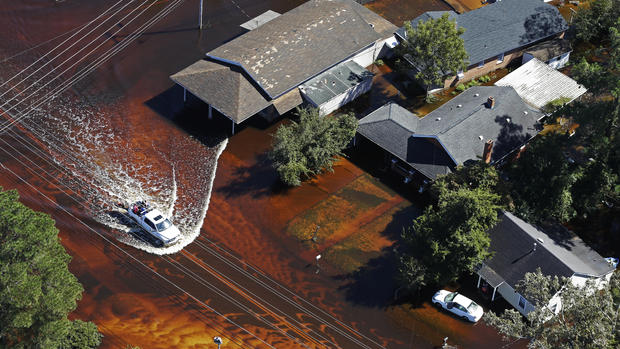Hurricane Matthew's death toll soars in Haiti and cholera fears grow
JEREMIE, Haiti -- Jislene Jean-Baptiste and her neighbors had little before Hurricane Matthew -- and now they have a lot less.
A grandmother who lives with her three daughters and their children in a one-room house in the devastated town of Jeremie, Jean-Baptiste was surveying what remained of her home Friday after Matthew tore across southwestern Haiti three days earlier.
There wasn’t much. Storm surge flowed across the road and drenched everything she owns in waist-deep salt water, washing away the stores of rice and sugar she sells at the market to support her family. Then the wind tore off her roof.
“That storm was the most terrifying thing that ever happened here,” she said.
Many of her neighbors are in a similarly dire situation because of a storm that killed hundreds of people in Haiti. Its government has estimated at least 350,000 people need some kind of assistance in what is likely the country’s worst humanitarian crisis since the devastating earthquake of January 2010.
Amid the suffering, aid began pouring into the coastal town of Jeremie, where thousands of homes were damaged or destroyed and many people were running low on food and facing an increased risk for cholera. Dozens of young Haitians came to the small airstrip along the coast to watch as a helicopter was unloaded with crates of food and water.
The U.S. military is mobilizing to help. The Navy said Friday it’s sending the Norfolk, Virginia-based USS Mesa Verde, an amphibious transport dock ship, toward the island. The ship is loaded with 300 Marines from Camp Lejeune in North Carolina, one landing craft and three large helicopters. The Navy said they’ll be able to quickly distribute relief.
Lt. Jeffrey Prunera said two other ships, the USS George Washington aircraft carrier and the USS Comfort hospital ship, are awaiting further orders in the South Atlantic to possibly help as well.
The military has established Joint Task Force Matthew to oversee its relief efforts. By Friday afternoon, 170 personnel and nine helicopters had already reached the country.
Estimates of the number of dead varied greatly.
The country’s Civil Protection Agency said the death toll was still at nearly 300, but officials conceded it was likely higher because the central government had not received totals from much of the Grand Anse region because communications were still largely down across the rural and mountainous area.
The Reuters news service said the number was at least 877, with information trickling in from remote areas that had been cut off by the storm that pummeled parts of Haiti with 145 mph winds.
When Category 4 Hurricane Flora hit Haiti in 1963, it killed as many as 8,000 people.
A Haitian-American pastor in Miami says parishioners hoping to hear from loved ones back home are hearing nothing but silence.
Father Reginald Jean-Marie, pastor of Notre Dame d’Haiti Church, said many Haitian congregants are waiting anxiously on news from loved ones in their homeland.
“There’s no contact. Total silence. We haven’t heard much,” he said Friday.
The storm left signs of devastation all around the southwestern peninsula. Outside Jeremie, home after home was in ruins. Drew Garrison, a Haiti-based missionary who flew in Friday, said several fishing villages were submerged and he could see bodies floating in the water.
“Anything that wasn’t concrete was flattened,” said Garrison, whose organization, Mission of Hope Haiti, based in Austin, Texas, was bringing in a barge loaded with emergency supplies on Saturday. “There were several little fishing villages that just looked desolate, no life.”
The Pan American Health Organization and others warned of a surge in cholera cases because of the widespread flooding caused by Matthew. Haiti’s cholera outbreak has killed roughly 10,000 people and sickened more than 800,000 since 2010, when it was introduced into the country’s biggest river from a U.N. base where Nepalese peacekeepers were deployed.
Sophia Cheresal, deputy medical coordinator of Doctors Without Borders in Haiti, said there were at least 18 cases of cholera at the Jeremie hospital. “It’s getting worse and probably some people are going to die.”
U.N. emergency relief coordinator Stephen O’Brien called the hurricane’s damage a major blow to Haiti’s reconstruction effort and the fight against cholera.
“We expect that homes, schools and cholera treatment facilities have been destroyed and that water systems, roads and bridges have been severely damaged,” he said in a statement that also announced that the U.N.’s Central Emergency Response Fund was releasing $5 million to help Haiti. Earlier this week, the fund released a loan of $8 million to UNICEF to scale up response to Haiti’s cholera epidemic.
Solette Phelicin, a mother of five who lost her home and her small fruit and vegetable plot, watched from her yard as U.N. peacekeepers patrolled the airstrip. She said they were hungry and desperately in need of food.
“Jeremie might get rebuilt after I’m dead, maybe, but I doubt it,” she said.
As Haitians mourned their losses, they tried to recover what they could of their belongings. Homes throughout the area were piles of rubble, the roofs mangled or stripped away.
Officials were especially concerned about the department of Grand-Anse on the northern tip of the peninsula, where they believe the death toll and damage is highest.
